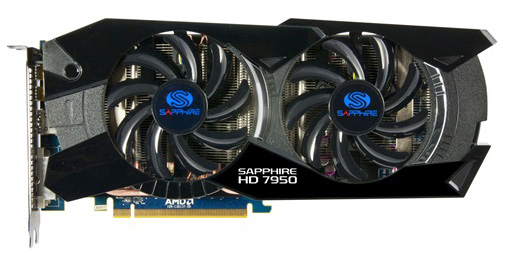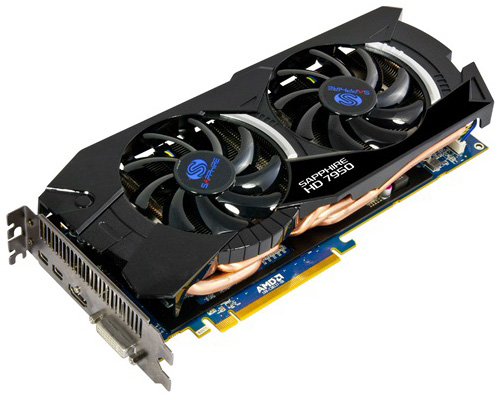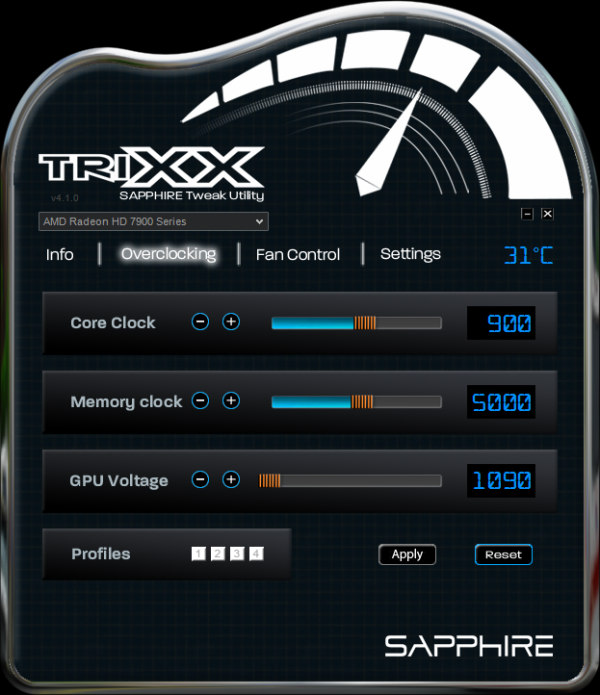AMD Radeon HD 7950 Review Feat. Sapphire & XFX: Sewing Up The High-End Market
by Ryan Smith on January 31, 2012 9:02 AM ESTMeet the Sapphire HD 7950 Overclock Edition
Since our reference 7950s are built on the 7970 PCB and cooler, we’re going to jump right into our vendor cards starting with the Sapphire HD 7950 Overclock Edition.
As with all of the 7950 cards launching today, Sapphire’s HD 7950 Overclock Edition uses the AMD 7950 PCB. This is a slightly shorter PCB measuring 10.25” long, saving .25” over the 7970 PCB by eliminating a few components that the lower board power of the 7950 makes unnecessary. The PCB is otherwise very similar to the 7970 PCB, utilizing 12 GDDR5 memory chips organized around the Tahiti GPU, while at the top you’ll find the 2 CrossFire connectors, a pair of 6pin PCIe power sockets, and the BIOS selection switch. The latter will be of particular interest to unlockers, as the switch should make it possible to safely attempt to unlock the 7950 into a 7970.

Moving on, as this is a semi-custom card the real differentiation is in the factory overclock and the cooler. On the performance side of things Sapphire will be shipping the 7950 Overclock Edition at 900MHz core and 5GHz memory, representing a 100MHz (12.5%) core overclock and no change on the memory clock.
Meanwhile for the cooler Sapphire is using what they’re calling the Dual-X cooler. The Dual-X is yet another double-wide dual-fan open air cooler, with 2 fans providing copious airflow over an aluminum heatsink running virtually the entire length of the card. Sapphire’s fan cutouts are just a bit bigger than most other dual-fan coolers and placed a bit higher, and as a result the Dual-X cooler is a bit taller than the PCB by about 15mm at its highest point. Meanwhile the cooler is also a fair bit longer than the PCB, putting the total card length at 11”.
Moving below the fans and the heatsink we’ll find the heatpipe assembly, which is responsible for carrying heat from the GPU to the heatsink. The Dual-X uses 5 copper heatpipes of varying radius that run from one end of the heatsink to the other. The 5 heatpipes converge at the base of the assembly, where a copper baseplate provides contact with the GPU. Meanwhile cooling for the VRM MOSFETs and RAM is provided by a black aluminum plate, which is placed over those components with heat transfer provided by the use of thermal pads. There is no connection between the plate and the heatsink, so the only heat dissipation from the plate is provided by whatever airflow from the fans reaches the plate.

At the front of the card we’ll find the display ports, which as this is an AMD PCB the card utilizes the standard AMD 7000 series port configuration of 1 DL-DVI port, 1 HDMI port, and 2 mini-DisplayPorts. Filling out the second slot is the grating for ventilation, though even with the ventilation slot the usual precautions for an open-air cooler apply: you’ll need a case with enough airflow to handle the roughly 200W of heat the card is capable of dumping inside of your case.
Rounding out the package is the usual collection of dongles and materials. Sapphire includes 2 molex-to-6pin PCIe adaptors, an HDMI to DVI dongle, a miniDP to DisplayPort dongle, a DVI to VGA dongle, and a 1.8m HDMI cable. Along with the dongles Sapphire packs a quick start guide and a driver installation CD.
The only thing you won’t find packed in the box is TriXX, Sapphire’s in-house overclocking utility. TriXX has been around since the 6900 series, but as this is the first high-end Sapphire card we’ve reviewed since it was released, this is the first time we’ve had it available for a review.
Fundamentally TriXX is a fairly well designed, albeit barebones overclocking utility. Along with an info readout similar to GPU-Z, TriXX provides overclocking and fan control support for Sapphire’s cards, including support for custom fan profiles and more importantly voltage control. With TriXX it’s possible to overvolt most of Sapphire’s performance and high-end cards, and as Sapphire uses AMD reference PCBs it also works with any other cards using AMD’s PCBs.
Beyond these features there’s little more to TriXX. It’s not an all-encompassing video card utility like MSI’s Afterburner, which means it comes up short if you need more functionality but it's exactly what you need if you just want to overclock. To that end it’s a clear step up compared to most other manufacturer’s poorly designed utilities, and from a design perspective its only real sin is the hard to read blue-on-black text. Otherwise it’s a competent overclocking utility that does exactly what it’s supposed to and provides voltage control for those who need it.
Finally, Sapphire will be selling the 7950 OE for $479, $30 over the baseline 7950 MSRP. Meanwhile the warranty on their card is their standard 2 year warranty.















259 Comments
View All Comments
nissangtr786 - Wednesday, February 1, 2012 - link
At the end of the day the 7970 and 7950 are great cards. They are like going from a 65nm pentium 4 to a 45nm core 2 duo in terms of performance per watt. Yes AMD may have not cranked the power consumption like amd do but performance per watt or gflops per watt it is basically double or even better then the last generation 40nm cards.Imagine 10000 40nm gtx 580 running in the world or 10000 7950 running in the world. Saving 160w more each person with similar person. 160w is a lot of power enough to run nearly an m17x r3 with 6970m.
160w multiplied by 10000 people = 1600000 watt difference for same performance of a gtx 580 and 7950. Thats 1.6m watts in simple terms more to game. If process and architecture changes of cpus and graphics cards didn't happen we would still have pentium 4's running at 3.8ghz with 6800 utras taking nearly as much power to run as an i7 3960x and 7970. Also idle watts usage go down every die shrink.
JNo - Thursday, February 2, 2012 - link
I'm surprised you didn't give the Sapphire a Gold Editor's choice award.It is pretty much awesome in every respect and I don't see any drawbacks.
No I don't work for Sapphire but this is the card I'd buy tomorrow (if I really needed it/had more money!)
Finally - Thursday, February 2, 2012 - link
Sapphire did do their homework. I find it astonishing that they were the only ones to consider undervolting, while also overclocking their product. Hats off!chizow - Thursday, February 2, 2012 - link
No, Tahiti is competing with the expectations of a new generation of hardware, expectations they clearly failed to meet. You don't ask for flagship prices when all you bring to the table is refresh performance of 14 month old last-gen parts. If you don't think so, but hey np, I have a copy of Madden 2010 you can buy for $60.How are my expectations too high? More like your expectations are too low if you were impressed with Tahiti. 15-25% faster than the last-gen flagship? Is that a joke? Once again, next-gen expectations commanding flagship prices should be AT LEAST 50% before anyone considers buying. Y'know, the same speed bump that "clusterfk" Fermi was over the last-gen parts...... Once again low expectations of AMD fans just used to being mediocre I suppose....
And to disprove your nonsense again with historical fact, Nvidia did have the fastest card in 2010 with GTX 480, but instead of raising the prices, they kept it the same with the GTX 580. They've done this in the past as well with the GTX 280 > GTX 285. They don't raise prices on refreshes, they also don't raise prices on flagships on new generations because they learned their lesson with GTX 280 after the original pricing fiasco.
chizow - Thursday, February 2, 2012 - link
Wrong again.The rebates were funded by Nvidia for price protected "exclusive" partners in NA and EU markets. At the time, that was EVGA, BFG and XFX.
The partners only sent out the rebate because they received the bulk of payment after shipping to retailers, but only with Nvidia's green light. Nvidia also directly funded/reimbursed or promised more inventory using the credited difference for any existing stock in the channel when they officially dropped the price of the GTX 280 from $650 to $500 and the GTX 260 from $450 to $350. Prices on the top two cards have stayed virtually the same since.
But yes, AMD is setting themselves up for a similar fall. If they priced the 7970 the same as the previous flagships, $500. No one would care that much. If they priced the 7950 the same as their previous 2nd tier, $380-400. No one would care that much.
But they got greedy. For what? 15-25% improvement on a new architecture, full node, and 14 months? History is due to repeat itself, and not in AMD's favor. At least in Nvidia's case, the GTX 280 actually warranted its pricetag relative to last-gen parts. You can't even say that about the 7970.
chizow - Thursday, February 2, 2012 - link
Well if a $300 card is priced where it should be and performs the same as AMD's $450 card something will certainly have to budge.Unless Nvidia decides to just refresh their old parts on 28nm and prices everything the same for a 5-10% increase in performance.
In that case, we can all just not buy video cards this generation because nothing will be worth buying and we can stop pretending these new cards are some awesome new innovation.
chizow - Thursday, February 2, 2012 - link
They're still $500 because demand is still strong, its close to EOL, and people still find value in Nvidia parts over AMD.They'll drop the prices to sell off the last few in the channel when they replace the part with something better, but in the meantime, AMD hasn't given any reason for them to slash the prices due to their greedy pricing on the 7950.
Again, this is a departure from past launches where AMD did price their parts sensibly and forced Nvidia to lower prices on its flagship cards (GTX 285 etc).
4 of 11 out of stock is good? After 4 days on the market? I don't think so. I think the market has spoken given every other major launch in the last few years on a high-end SKU like this has resulted in OOS for about a month.
Demand for this part is soft, and at its price/performance that's no surprise and really shouldn't be.
chizow - Thursday, February 2, 2012 - link
Really? So being the highest-end SKU that AMD produced and within 10-15% of the fastest single-GPU on the planet, it wasn't a high-end card? And I guess AMD didn't have any high-end cards that generation?And "pricing ALWAYS based on performance relative to the competition". So the RV770 coming within 10-15% of the GTX 280 which already launched for $650 and was selling briskly because it deserved that pricing relative to last-gen (9800GX2, 8800GTX) and AMD pricing this part for $299 made sense based on performance relative to the competition? Really?
You're wrong. Stop posting LMAO. RV770 was a price mistake on AMD's part, a mistake they've been trying to correct ever since. Now Nvidia has a chance to return the favor because the 7970/7950 are going to be in a similar position due to the fact they're mispriced based on last-gen metrics.
chizow - Thursday, February 2, 2012 - link
Newsflash: if you want the newer part, you actually expect better performance for the same price compared to parts that have been out for over a year.Welcome to my used car lot where I sell old cars for brand new prices.
chizow - Thursday, February 2, 2012 - link
And that's exactly what's wrong with their pricing, an error that will be obvious once its competing against the products its supposed to be competing with.By your same flawed logic, graphics cards would be thousands of dollars as every incremental increase would incur an increase in price without limits.